- April 25, 2024
-
-
Loading

Loading

Some of the sand that seven past and present Longboat Key commissioners and Town Manager Dave Bullock stood on when they cut the ribbon June 30, for a new $2 million sand and groin project on the north end of Longboat Key is already gone.
In less than two months, the shoreline near the North Shore Road beach access has lost approximately 5,000 cubic yards of sand that was placed in and around two groins built to stop the rapid flow of island sand from being dumped into Longboat Pass.
Longboat Key Commissioner Phill Younger believes the loss of sand is the result of an engineering shortfall, while town staff attributes it to two stormy months and takes a wait-and-see approach to the groins as the shoreline adjusts to the structures.
At low tide, Younger says that concrete teeth, or baffling, used to help stop the flow of sand to hold a beach, are nonexistent right now in the seaward sections of the groins that jut into the Gulf.
“It is intuitively obvious that if nothing exists to impede the flow of sand (north toward Longboat Pass), the flow of sand will not be impeded,” Younger said. “It’s like putting up a fence without the slats.”
Younger believes Coastal Engineering & Planning, the contractor hired to install the groins and make the initial adjustments, needs to come back to adjust the groins to stop more sand from flowing through the structures into the pass.
“The contractor should remedy the situation by immediately installing more baffling on the Gulf-ward end of the groins at no additional cost to the town and share in the cost of sand lost as a result of failure to initially install the baffling,” Younger said.
“It is intuitively obvious that if nothing exists to impede the flow of sand, the flow of sand will not be impeded. It’s like putting up a fence without the slats.”
— Commissioner Phill Younger
Town Manager Dave Bullock said he spoke with Younger about his concern and is looking into the issue.
When he returned from his vacation last month, Bullock assessed the shoreline and said most of the sand placed during a recent nourishment and groin project is still in place.
“There remains in place a wide protective beach in front of 360 North condominiums and along North Shore Road,” Bullock said. “Some of the sand south of the southern groin has washed through the southern groin as expected.”
Bullock believes the recent rainy weather resulted in above-average high tides, exacerbating loss of sand in the area.
“Nature will continue to move sand in this area just as she does along the entire shoreline,” Bullock wrote in an email last week to commisioners.
Bullock also points out that the town expects a permit any day for a Longboat Pass dredging project that will bring 239,000 cubic yards of sand to the north end of the island.
Public Works Director Juan Florensa calls the loss of sand so far “sacrificial sand.”
“We had enough money left over from the groin project money to put more sand there during the (ribbon cutting) ceremony,” Florensa said. “That sand, as expected, eroded after three or four weeks of storms.”
Younger doesn’t believe the sand should be labeled as sacrificial.
“Longboat’s citizens have made a sizable investment in protecting the north end of our island and I cannot recall any comments prior to construction that sand placed in conjunction with the groins was to be considered ‘sacrificial,’” Younger said.
Florensa said the shoreline needs time to adjust to the groins. He notes there were complaints for a few years from neighbors about two groins installed in a highly erosive part of the beach near the Islander Club in 2008.
“We monitored the Islander groins for two years before we adjusted them,” Florensa said. “Design engineers have stated before we add or remove teeth elements, we need to give the shoreline more time to equilibrate.”
Younger, though, says you don’t need to give the shoreline anymore time to equilibrate, noting he believes the groins are acting more like piers than groins.
“Given there are no baffles Gulfward where the sand is lost, waiting for two years for something to equilibrate when it’s not there to equilibrate anymore doesn’t seem to make any logical sense,” Younger said. “Putting more sand in at a later date without the baffles will wash away like the same sand we already lost without the baffles. The baffles need to be put into place and put in place now.”